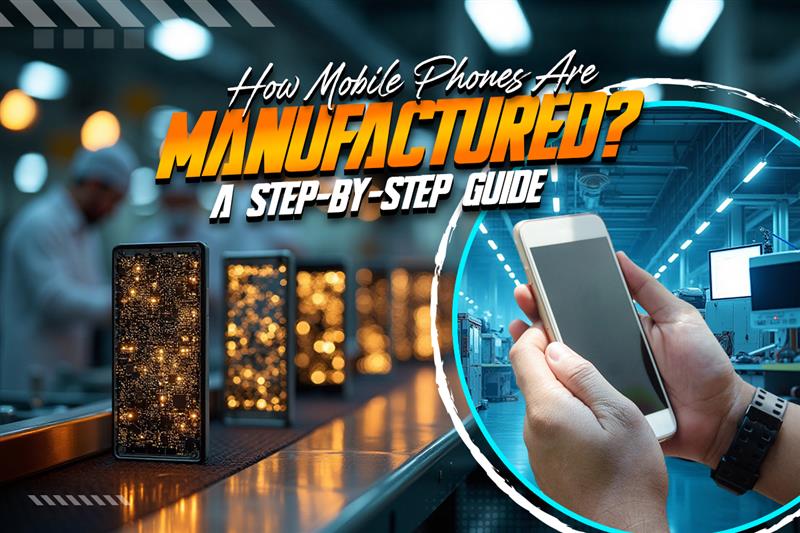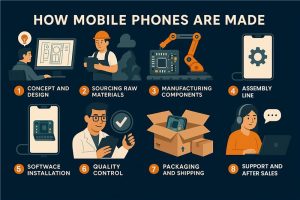Step 1: Concept and Design
Production starts way before any physical components are built. It begins with a thought.
1 Market Research
Manufacturers develop thorough research to find out what their customers need, trends in the market, as well as devices from competing companies. This impacts the features, dimensions, price, as well as software needs.
2 Industrial Design
Then there is the appearance of the phone—its shape, material, thickness, screen size, button locations, and even color. Industrial designers utilize computer programs such as CAD (Computer-Aided Design) to realize their designs.
3 Hardware & Software Planning
Hardware engineers determine the internal parts of the phone—processor, memory, battery, camera units, sensors, etc. At the same time, software groups plan the way the operating system and programs would operate smoothly on this hardware.
Step 2: Sourcing Raw Materials
A mobile phone is made up of dozens of components acquired from across the world. For instance:
- Lithium, cobalt, and graphite for batteries
- Gold, copper, and tin for internal wiring and circuitry
- Silicon for chips and processors
- Rare earth metals for displays and speakers
These raw materials are extracted, processed, and subsequently exported to part manufacturers who turn them into functional parts.
Step 3: Manufacturing Components
In contrast to a single factory, components of a mobile phone are produced by specialized suppliers in various countries.
1 Circuit Boards
The motherboard (or logic board) is the core of the phone, linking all the significant components. It’s typically produced by precision robotics to position micro-components such as resistors, capacitors, and chips.
2 Display Panels
Screen manufacturing involves creating LCD or OLED panels, touch sensors, and protective glass layers like Gorilla Glass. This step demands microscopic precision.
3 Batteries
Lithium-ion batteries are manufactured in secure environments to ensure safety and longevity. They’re rigorously tested to prevent overheating or leakage.
4 Camera Modules
Camera systems are among the most complex parts, requiring lenses, image sensors, autofocus motors, and sometimes multiple lenses for wide, zoom, or depth effects.
Step 4: Assembly Line
After all parts are in readiness, they are transported to a common factory (usually located in nations such as China, Vietnam, or India) where they are finally assembled.
1 PCB Integration
The motherboard is fitted within the phone frame. Other parts—such as RAM, CPU, and modem—are soldered or clicked into position.
Precision PCB cards are crucial in mobile phone manufacturing, especially during the integration of the motherboard, as they ensure seamless connectivity between components. Explore our high-performance PCB cards designed for industrial and electronics applications.
2 Screen Mounting
The screen is mounted on the frame, often with mechanical fasteners or strong adhesives. Touch sensors and fingerprint readers (if they exist) are incorporated.
3 Placement of Camera and Battery
Camera modules and the battery are precisely placed to meet design requirements. Placement in the right position helps ensure performance and durability.
4 Wiring and Connectors
Thin cables and connectors connect various pieces—such as the microphone, speakers, vibration motor, and charging port.
5 Sealing the Phone
The phone is then closed with the back panel, either by screws, clips, or adhesives. Waterproof phones undergo an additional sealing process using rubber gaskets and pressure testing.
Step 5: Software Installation
Having prepared the hardware, it’s time to install the brain—the software.
1 Operating System
Android or iOS, the OS is installed on the phone’s internal memory. This includes the interface, core apps, and settings.
2 Custom Software
Manufacturers then add their own custom skins, features, and branded apps on top of the stock OS.
3 Testing Phase
The phone goes through extensive testing before it leaves the factory:
- Functionality (touch, buttons, camera, mic, etc.)
- Network testing (WiFi, Bluetooth, SIM detection)
- Performance benchmarking
- Drop tests and water resistance (if applicable)
Any defective unit is repaired or discarded.
Step 6: Quality Control
Each phone has to meet quality assurance (QA) standards. This includes:
- Visual inspection for scratches, dents, or misalignment
- Software bug/lag testing
- Safety checks for the battery to prevent overheating
- Accessory compatibility (charger, earphones, etc.)
Only those phones that satisfy the highest levels are certified for packaging.
Step 7: Packaging and Shipping
After the phones are certified:
- Accessories such as chargers, cables, user guides, and occasional earbuds are packaged with the phone.
- Packaging is customized for branding and shipping protection.
- Warehousing consists of storage within climate-controlled conditions prior to distribution.
- Phones are thereafter distributed to retailers, wholesalers, or directly to consumers.
Step 8: Support and After-Sales
Even after selling and production, organizations offer software upgrades, customer support, and repair. This is a continuous component of the life cycle of the mobile phone and important for a company’s image.

